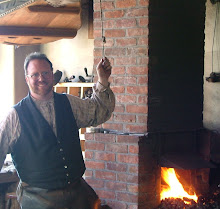The Farmers' Museum has a wealth of traditional buildings, garden gates, and farm gates with forged hinges.
Our hardware is purposefully not all of the same style. That allows us to demonstrate a wide range of traditional hardware.
Pintle and Gudgeon hinges are found on barn doors and are usefull as hinges that carry a heavy load. The L shaped part that nails or bolts to a beam and forms the pivot is the Pintle.
The loop on the Hinge Strap that acts as the bearing surface is the Gudgeon. These are very strong and work well regardless of the weather.
Hay loft door often have strap hinges with pintles and gudgeons. These are on our Hop Barn and the Morey Barn.
Pintle Hinges are found on many of our barn doors and some of the field and paddock gates. The long strap of the hinge makes the door or gate quite strong.
That is important when Farm animals are leaning on the gate! If my hinge broke that would leave me feeling sheepish! There are some special purpose hinges on our grounds as well. One of my favorites are the self-closing garden gate hinges.
These are on the Dimmick House garden gate.
These are on the Dimmick House garden gate.
Cut at an angle, they use gravity to shut the gate automatically after it has been opened. They are quite handsome as well. This is only a small sample of the many types and styles of hinges here at The Farmers' Museum.














